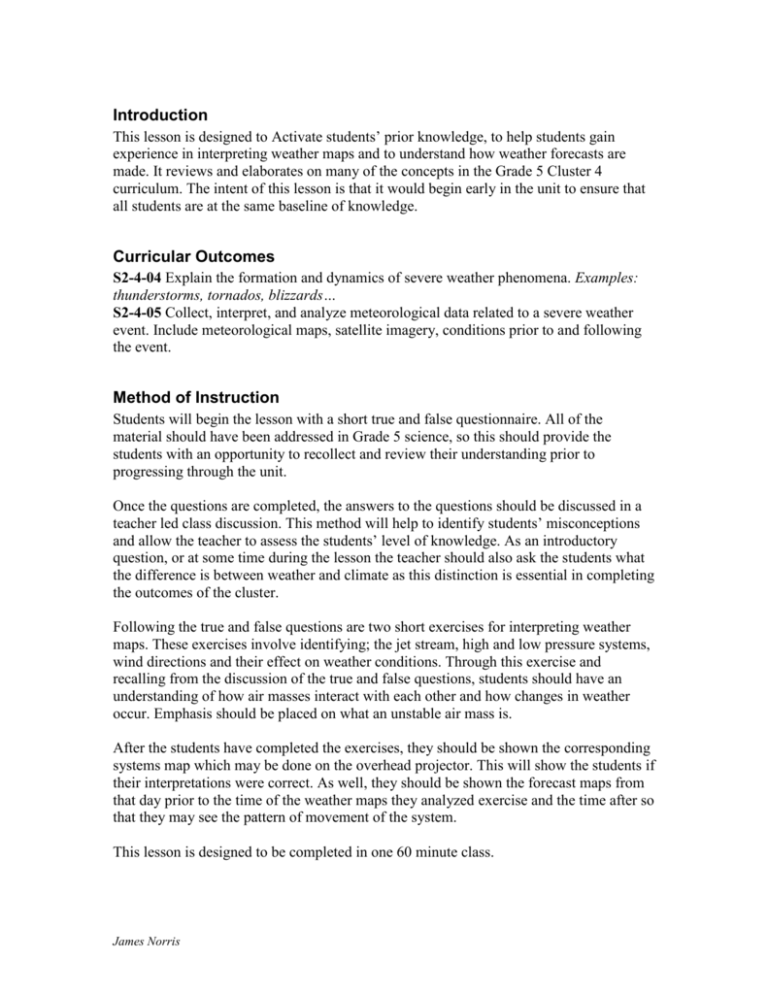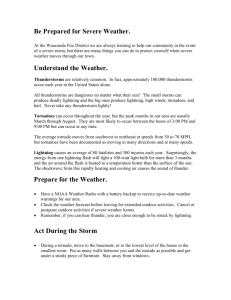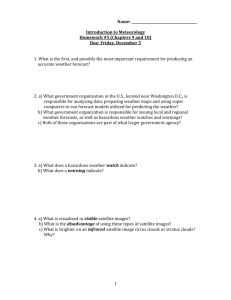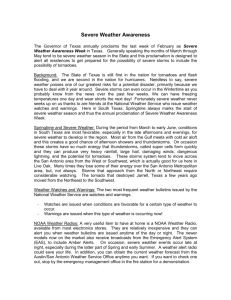Manitoba Weather – Summer Storms
advertisement

Introduction This lesson is designed to Activate students’ prior knowledge, to help students gain experience in interpreting weather maps and to understand how weather forecasts are made. It reviews and elaborates on many of the concepts in the Grade 5 Cluster 4 curriculum. The intent of this lesson is that it would begin early in the unit to ensure that all students are at the same baseline of knowledge. Curricular Outcomes S2-4-04 Explain the formation and dynamics of severe weather phenomena. Examples: thunderstorms, tornados, blizzards… S2-4-05 Collect, interpret, and analyze meteorological data related to a severe weather event. Include meteorological maps, satellite imagery, conditions prior to and following the event. Method of Instruction Students will begin the lesson with a short true and false questionnaire. All of the material should have been addressed in Grade 5 science, so this should provide the students with an opportunity to recollect and review their understanding prior to progressing through the unit. Once the questions are completed, the answers to the questions should be discussed in a teacher led class discussion. This method will help to identify students’ misconceptions and allow the teacher to assess the students’ level of knowledge. As an introductory question, or at some time during the lesson the teacher should also ask the students what the difference is between weather and climate as this distinction is essential in completing the outcomes of the cluster. Following the true and false questions are two short exercises for interpreting weather maps. These exercises involve identifying; the jet stream, high and low pressure systems, wind directions and their effect on weather conditions. Through this exercise and recalling from the discussion of the true and false questions, students should have an understanding of how air masses interact with each other and how changes in weather occur. Emphasis should be placed on what an unstable air mass is. After the students have completed the exercises, they should be shown the corresponding systems map which may be done on the overhead projector. This will show the students if their interpretations were correct. As well, they should be shown the forecast maps from that day prior to the time of the weather maps they analyzed exercise and the time after so that they may see the pattern of movement of the system. This lesson is designed to be completed in one 60 minute class. James Norris Manitoba Weather – Summer Storms T or F 1. Thunderstorms are most common in the late afternoon. True. Throughout the day water from the Earth evaporates and rises into the atmosphere. As it gets higher the temperature cools. This forces the moisture to collect forming a “thunderhead”. 2. Tornadoes are created by thunderstorms. True. Tornadoes created from the same clouds that form thunderstorms. 3. All thunderstorms have lightning. True. Thunder is the result of lightning. It can’t be a thunderstorm without thunder and there can be no thunder without lightning. Thunder is the sound of the ‘spark’. 4. As long as I am wearing rubber soled shoes I cannot be struck by lightning. False. Rubber soled shoes do nothing to protect you. You are still grounded to the Earth and may still be struck. Lightning will take the path of least resistance to get to the ground. 5. A thunderstorm warning means conditions are favorable for a thunderstorm to develop. False. A warning means the storm already exists and it is on the way. A watch means conditions are favorable for the storm to develop. 6. Tornadoes only occur on rainy days. False. Tornadoes are created by thunderstorms. The development of thunderstorms requires warm air masses. The easiest way to make warm air is on a bright sunny day. 7. Tornadoes usually last for 20 minutes or less. True. Tornadoes occur in unstable air masses. This means the conditions are constantly changing. It takes a lot of energy to maintain a tornado. As the conditions change the intensity of the twister will change too. The conditions are not held constant for very long because of the instability of the storm. 8. Tornadoes can be forecasted in advance just like thunderstorms. False. Tornadoes cannot be forecast at all. The best we can do is predict the conditions are most likely to develop a tornado. Tornadoes occur in an instant. Radar can show the depth of the clouds and the rotation, but even that does not indicate that the tornado will touch down. 9. A tornado is only dangerous if it touches down. False. The damage from the tornado is caused when it touches down because the winds have reached the ground where all of the structures are, but a tornado can drop down at any moment without warning. While it is spectacular to observe, watching a tornado is like standing on a busy freeway to watch the cars. It is very dangerous. James Norris 10. You can fly up in inside a tornado just like in the movies. True. In theory, but unlikely. The Tornado seeks warm air to maintain its energy. It can pick this up from the warm ground, causing an updraft. However you are not well connected to the ground, so before the center of the tornado ever got over you, you could be blown away from the outside of the tornado first. James Norris Predict the Weather Cincinnati 1. Label the Jet stream 2. Label the wind directions around the High and Low pressure systems. 3. What is it like in Winnipeg? How can you tell? _________________________________________________ _________________________________________________ 4. According to this map, which city do you think is currently warmer? Cincinnati ______ or Halifax _____? 5. What do you think the current weather is like in Halifax? _________________________________________________ _________________________________________________ 6. What will the weather in Halifax be like tomorrow? _________________________________________________ _________________________________________________ James Norris A. B. 1. Looking at both maps, where to you expect the unstable air masses to be? Circle the area on map A. 2. Label on the maps where warm moist air is coming from with a Big – M. 3. Label on the maps where the cool dry air is coming from with a Big – D. 4. Describe the air flow in this area which makes the air mass unstable. _________________________________________________ _________________________________________________ _________________________________________________ _________________________________________________ 5. What severe weather watches or warnings would you issue for this area? _________________________________________________ _________________________________________________ James Norris James Norris James Norris Manitoba Weather – Summer Storms T or F 1. Thunderstorms are most common in the late afternoon. 2. Tornadoes are created by thunderstorms. 3. All thunderstorms have lightning. 4. As long as I am wearing rubber soled shoes I cannot be struck by lightning. 5. A thunderstorm warning means conditions are favorable for a thunderstorm to develop. 6. Tornadoes only occur on rainy days. 7. Tornadoes usually last for 20 minutes or less. 8. Tornadoes can be forecasted in advance just like thunderstorms. 9. A tornado is only dangerous if it touches down. 10. You can fly up in inside a tornado just like in the movies. James Norris Predict the Weather Name:_____________ Cincinnati 1. Label the Jet stream 2. Label the wind directions around the High and Low pressure systems. 3. What is the weather like in Winnipeg? How can you tell? ____________________________________________ ____________________________________________ 4. According to this map, which city do you think is currently warmer? Cincinnati ______ or Halifax _____? 5. What do you think the current weather is like in Halifax? ____________________________________________ ____________________________________________ 6. What will the weather in Halifax be like tomorrow? ____________________________________________ ____________________________________________ James Norris A. B. 1. Looking at both maps, where to you expect the unstable air masses to be? Circle the area on map A. 2. Label on map A where warm moist air is coming from with a Big – M. 3. Label on map A where the cool dry air is coming from with a Big – D. 4. Describe the air flow in this area which makes the air mass unstable. ____________________________________________ ____________________________________________ ____________________________________________ 5. What severe weather watches or warnings would you issue for this area? ____________________________________________ ____________________________________________ James Norris





